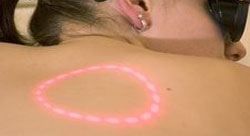Many people think that moles are “just” a minor skin problem. People often go through their lives as though their birthmarks and moles are “fine”; they feel it’s a normal skin condition. Not all moles can be ignored. Some can turn out to be harmful or even fatal if not taken care of at the right time.
When people want to be rid of unsightly or potentially harmful moles, they may be skeptical of the process at first. Today, medical science offers a number of ways by which you can remove your moles with little to no pain from the comfort of your own home. Though mole removal is simple and can be taken care of through over-the-counter products, a dermatologist visit is recommended to ensure the mole isn’t malignant.

Different types of mole removal treatment:
- Laser therapy
- Excision
- Cryotherapy
Laser therapy: This is the most popular form of therapy chosen by patients who can afford it or have it included in their insurance plans. Laser treatment is a painless way to remove a mole with surgical procession while doing it without creating an open wound. In this process, the laser surgeons burn the mole off of the skin and cauterizes the flesh at an even level. This is the fastest process of all mole removal techniques.
Excision: The surgeon uses local anesthesia and cuts the mole off using a scalpel. This method may also require the surgeon to stitch beneath the surface of the skin if the cut is deep.
Cryotherapy: In this method, liquid nitrogen is sprayed on the mole. The mole freezes, and then the cryotherapist removes it with a surgical lance. The depth of the cut will depend on the mole.
There is one method other way to remove a mole if you’re patient: the natural process of mole removal. There are plenty of natural herbs and crèmes are available these days which can be applied on the mole that will diminish it over time.
The process of mole removal that you’ll choose will depend on the type of mole that you need gone. There are two types of moles:
The first type is non-malignant and isn’t harmful. They normally appear at birth and grow due to the exposure to sun. These types of moles don’t change and are benign in nature.
The second types of moles grow in size as well as deepen in color. A doctor must examine these kinds of moles immediately upon first notice that the mole is changing. These moles may be cancerous.
If you need to see a skin specialist to get your mole examined, now is the time. You need to ask your local skin specialists about which mole removal technique will be best. The correct mole removal will be efficient and quick, catering to the size and severity of your mole. It is always advisable that before you go for a mole removal therapy, you consult more than one dermatologist. This ensures that you’ll find lasting removal treatment.
